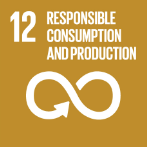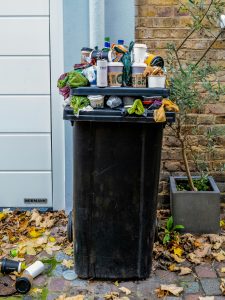SDG12 – Responsible Consumption and Production

New Vocabulary
- wisely
- resources
- consume
- shift
- over consumption
- degradation
- enforce
- eco-friendly
- generation
Practice the new vocabulary
Responsible Consumption and Production Vocabulary Practice (text version)
Match the words with their definitions
Words:
- generation
- wisely
- degradation
- resources
- consume
- shift
- enforce
- eco-friendly
- over consumption
Definitions:
- in a smart way
- things you need, such as food, water, electricity
- use
- change the way of doing something
- use too much of
- damage or destruction
- to make sure something is done
- good for the environment
- all the people in one age or era
Check your answer in footnote[1]
Activity source: Responsible Consumption and Production Vocabulary by Virginia McHardy, CC BY-NC 4.0
Responsible Consumption and Production
According to the United Nations Department of Economic and Social Affairs (n.d.) Goal 12 Infographic:
Goal 12 is about using resources wisely so people today and in the future can have what they need.
Our planet is losing resources, but more people are being born. By 2050, the world may have 9.8 billion people. If we continue using resources the same way, we would need the resources of almost three planets.
We must change how we consume energy and other resources. One big shift is using cleaner energy instead of fossil fuels such as oil, coal and natural gas. However, in 2020 and 2021, many countries gave more money to support fossil fuels.
Regardless, some companies are starting to care more about the environment. More businesses are sharing reports on how they are working toward sustainability.
In addition, food waste is another big concern. Every year, 931 million tons of food are thrown away, even though many people do not have enough to eat. This is an example of over consumption. We need better rules, education, and technology to reduce food waste.
In the past 100 years, people have made progress, but they have also harmed the environment. This degradation is dangerous for our future.
Small changes can make a big difference.
- Governments need to make and enforce rules to reduce waste and encourage recycling.
- Companies should design products that last longer, can be fixed, and can be reused or recycled.
- People should buy less, choose eco-friendly products, and reduce pollution in daily life.
By making better choices, we can protect the planet for future generations.
Canadian Perspective
Goal 12, Responsible Consumption and Production (text version)
Ensure sustainable consumption and production patterns
Waste Diversion in Canada
In 2020, businesses and households diverted almost 10 million tonnes of materials from landfills, up 3.7% from 2018. Between 2018 and 2020, residential sources of diverted organics increased 10.2%. Total waste diverted per capita increased 1.1% between 2018 and 2020 to 261 kg per year.
Green Habits of Canadian Households in 2021
In 2021, 90% of households had at least one member who used their own refillable water bottle and among them, 85% always or often followed this habit. In 2021, 97% of households used their own bags or containers when grocery shopping and among them, 84% always or often followed this habit.
Zero-emission Vehicles
Annual registrations[2] represent 8.2% (123,562) of all vehicles registered in 2022. On the road to the target of 10% by 2025.
| Year | Number of zero-emission vehicles |
|---|---|
| 2015 | 6,888 |
| 2022 | 123,562 |
Community Spotlight: Équiterre
Équiterre seeks to transform our production and consumption system with the principles of the circular economy and reducing waste at the source. It contributes to the emergence of solutions, the transformation of social norms and the adoption of public policies.
Waste reduction: Campaigns and studies on obsolescence and access to repair for appliances and electronics. A 2022 study found that only 19% of Canadians who had an appliance break in the last 2 years had it repaired.[3]
Electric mobility: Awareness campaigns on electric mobility, with more than 45,000 electric car and electric bike test drives since 2018.
Food and agriculture: Support for the agri-food sector towards sustainable agricultural practices and increased procurement of environmentally responsible food.
Sources: Statistics Canada, Waste Management Industry Survey: Business Sector, 2020. Statistics Canada, Households and the Environment Survey, 2021. Statistics Canada, New Motor Vehicle Registration Survey, 2023. Équiterre, 2023.
Source: Goal 12, Responsible Consumption and Production In Agenda 2030 Sustainable Development Goals Report, 2022 by Statistics Canada, used under Open License
Discussion Questions
Use the new vocabulary words in these discussion questions. Ask and answer in partners or small groups:
- How can we use water wisely in our daily lives?
- What are some natural resources we use every day?
- What are some things people consume too much of?
- How can we shift to using more clean energy, like solar or wind power?
- What are the problems caused by over consumption of food and plastic?
- How does pollution cause degradation of the environment?
- Why is it important for governments to enforce recycling and waste rules?
- What are some eco-friendly habits people can do at home or work?
- What can we do to help future generations have a healthy planet?
Watch the video:
Watch Goal 12 – Responsible Consumption and Production (x mins) on YouTube
Video source: UNStats. (2022, July 7). Goal 12 – Responsible consumption and production [Video]. YouTube. https://www.youtube.com/watch?v=fYefSEYbV9c
Responsible Consumption and Production Video Quiz (text version)
- Fill in the missing words to complete the sentence:
The 3 effects that over consumption and production are creating are:- [Blank A] change
- [Blank B] loss
- [Blank C] pollution
- True or false? Globally, most electronics are safely disposed of.
- Where does food NOT go before it gets to the stores?
- transport
- restaurants
- storage
- Use the numbers provided to complete the sentence:
Numbers: 17%, 13.3%
Sentence: Before getting to the stores and restaurants, [Blank A] of the global food is lost. When it finally gets to the sellers, about [Blank B] is wasted.
Check your answers in footnote[4]
Activity source: Responsible Consumption and Production Video Quiz by Virginia McHardy, CC BY-NC 4.0
Key Targets for SDG 12
- 12.1 Implement the 10-Year Framework of Programmes on Sustainable Consumption and Production Patterns, all countries taking action, with developed countries taking the lead, taking into account the development and capabilities of developing countries.
-
12.2 By 2030, achieve the sustainable management and efficient use of natural resources.
-
12.3 By 2030, halve per capita global food waste at the retail and consumer levels and reduce food losses along production and supply chains, including post-harvest losses.
-
12.4 By 2020, achieve the environmentally sound management of chemicals and all wastes throughout their life cycle, in accordance with agreed international frameworks, and significantly reduce their release to air, water and soil in order to minimize their adverse impacts on human health and the environment.
-
12.5 By 2030, substantially reduce waste generation through prevention, reduction, recycling and reuse.
-
12.6 Encourage companies, especially large and transnational companies, to adopt sustainable practices and to integrate sustainability information into their reporting cycle.
-
12.7 Promote public procurement practices that are sustainable, in accordance with national policies and priorities.
-
12.8 By 2030, ensure that people everywhere have the relevant information and awareness for sustainable development and lifestyles in harmony with nature.
-
12.a Support developing countries to strengthen their scientific and technological capacity to move towards more sustainable patterns of consumption and production.
-
12.b Develop and implement tools to monitor sustainable development impacts for sustainable tourism that creates jobs and promotes local culture and products.
-
12.c Rationalize inefficient fossil-fuel subsidies that encourage wasteful consumption by removing market distortions, in accordance with national circumstances, including by restructuring taxation and phasing out those harmful subsidies, where they exist, to reflect their environmental impacts, taking fully into account the specific needs and conditions of developing countries and minimizing the possible adverse impacts on their development in a manner that protects the poor and the affected communities.
-
Source: United Nations Department of Economic and Social Affairs. (n.d.). Goal 12 [Infographic]. Sustainable Development Goals. https://sdgs.un.org/goals/goal12
Homework/Assignments:

1. Personal Reflection
Answer the following questions in 3-4 sentences each:
- How do you and your family use natural resources (food, water, energy) in your daily life?
- What is one small change you can make to be more sustainable?
- Why is it important to think about future generations when we consume resources?
2. Action Plan
Create a simple action plan:
- List three ways you can help reduce waste, save energy, or make more eco-friendly choices in your home or school.
You can read more about Goal #12 in The Sustainable Development Goals Report 2022 from the UN.:
For instructors, please visit York University’s The SDGs-in-the-Classroom Toolkit for lesson ideas
Attribution & References
Except where otherwise noted, this page is created by Virginia McHardy, CC BY-NC 4.0
References
United Nations Department of Economic and Social Affairs. (n.d.). Goal 12 [Infographic]. Sustainable Development Goals. https://sdgs.un.org/goals/goal12
- 1. wisely, 2. resources, 3. consume, 4. shift, 5. over consumption, 6. degradation, 7. enforce, 8. eco-friendly, 9. generation ↵
- Total zero-emission vehicles registered excludes buses, trailers, recreational vehicles, motorcycles, snowmobiles, golf carts, etc. ↵
- Équiterre, Working Towards Repairable Appliances and Electronics in Canada, 2022. ↵
- 1. a) climate, b) biodiversity, c) pollution. 2. False. 3. b) restaurants. 4. a) 13.3%, b) 17%. ↵
in a smart way
use
change the way of doing something
use too much of
damage or destruction
all the people in one age or era
things you need, such as food, water, electricity
to make sure something is done
good for the environment

